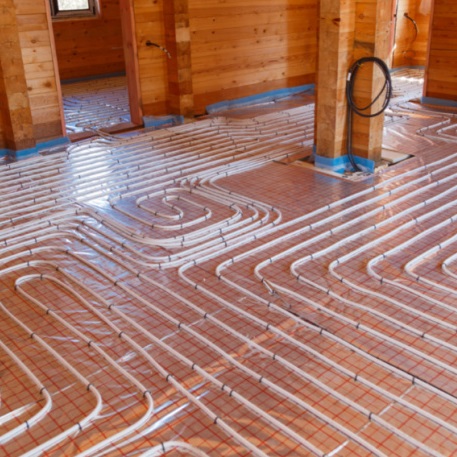
Types of In-floor Heating Systems
In the ever-evolving landscape of home heating solutions, one technology has steadily gained traction for its efficiency, comfort, and energy-saving benefits: in-floor heating systems. Imagine stepping onto a warm floor on a chilly winter morning, the cozy heat enveloping your entire space without needing bulky radiators or vents. In-floor heating systems have revolutionized how we keep our homes warm, offering a seamless and unobtrusive alternative to traditional heating methods. This comprehensive guide delves into the heart of this innovative heating solution, exploring the various types of in-floor heating systems that have transformed how we experience warmth in our homes. From radiant floor heating to hydronic systems, electric heating mats, and beyond, join us to uncover the diverse world of in-floor heating technologies. Whether you’re considering a home renovation or simply curious about the future of home heating, this article is your gateway to understanding the different types of in-floor heating systems and how they can bring unparalleled comfort and efficiency to your living space.
Hydronic Radiant Floor Heating:
Hydronic radiant floor heating systems work by circulating warm water through a network of tubing installed beneath the floor. This tubing can be installed in various ways: within a concrete slab (in new constructions or major renovations), attached to the subfloor (in existing homes or during more minor renovations), or placed between layers of floor materials like plywood or cement board. A boiler or a water heater heats the water, and a pump circulates the warm water through the tubing, radiating heat upward into the room. The heat from the floor then warms objects and people in the room, creating a comfortable and even warmth.

Pros of Hydronic Radiant Floor Heating:
- Energy Efficiency: Hydronic in-floor heating systems are highly energy-efficient because they can operate at lower temperatures than traditional forced-air systems.
- Even Heat Distribution: Unlike traditional heating systems that create hot and cold spots, hydronic radiant floor heating provides uniform warmth across the entire floor area, ensuring consistent comfort throughout the room.
- Zoned Heating: Hydronic systems can be divided into zones, allowing you to independently control the heat in different areas of your home. This flexibility can lead to energy savings by heating only the rooms that are in use.
- Quiet and Invisible: Unlike radiators or forced-air vents, hydronic systems operate silently and are hidden beneath the floor, saving space and allowing for more creative interior design options.
- Compatible with Various Flooring: Hydronic systems can be installed under various flooring materials, including tile, wood, laminate, and carpet, making them versatile and suitable for different interior designs.
- Compatible with Renewable Energy Sources: Hydronic systems can be integrated with solar water heaters or other renewable energy sources, reducing the system’s environmental impact.
Cons of Hydronic Radiant Floor Heating:
- Installation Cost: The initial installation cost of hydronic radiant floor heating can be higher than traditional heating systems, especially in existing homes where retrofitting is required.
- Installation Complexity: Proper installation requires careful planning and expertise, especially retrofitting an existing home.
- Response Time: Hydronic systems may have a slower response time than forced-air systems because it takes time for the water to heat up and circulate through the tubing. This can be a drawback if you need quick heating.
- Maintenance: While these systems are generally low-maintenance, any issues with the boiler or pumps can be more complicated and costly compared to more straightforward methods.
Electric Radiant Floor Heating:
Electric radiant in-floor heating systems consist of heating cables or mats installed beneath the floor. These heating elements are connected to the electrical supply and generate heat when an electric current passes through them. The heat produced warms the floor and, in turn, the room above.

Pros of Electric Radiant Floor Heating:
- Ease of Installation: Electric in-floor heating systems are relatively easy to install, especially in smaller areas or during renovations. Installation involves laying out the heating cables or mats, connecting them to the electrical supply, and covering them with the chosen flooring material.
- Individual Room Control: Electric systems can be installed in separate rooms, allowing for precise temperature control in specific areas of the house. This zoning capability can lead to energy savings by heating only the rooms that are in use.
- Quick Response Time: Electric radiant floor heating systems heat up quickly, providing almost instant warmth when turned on. This rapid response time makes them ideal for rooms that are used intermittently.
- Versatile Flooring Options: Electric systems are compatible with various flooring materials, including tile, stone, laminate, and engineered wood. This flexibility in flooring choices makes them suitable for various interior designs.
- Low Maintenance: Electric radiant floor heating systems require minimal maintenance once installed. There are no moving parts, and the plans are designed to be durable and reliable.
Cons of Electric Radiant Floor Heating:
- Operating Costs: Electric systems can be more expensive than hydronic systems, especially in regions with high electricity costs. However, improved insulation and energy-efficient flooring can mitigate these costs.
- Initial Installation Cost: While electric systems are easier to install than hydronic systems, the heating cables or mats and the electrical work can add up, making the initial installation cost a consideration for budget-conscious homeowners.
- Not Suitable for Large Spaces: Electric radiant floor heating may not be the most efficient option for heating large areas due to the higher operating costs. In such cases, hydronic systems might be a more cost-effective solution.
- Limited Heat Storage: Electric systems do not retain heat well after being turned off, so the floor might cool down relatively quickly once the system is not in operation. This lack of heat retention can impact energy efficiency.
Air-Heated Radiant Floor Systems:
Air-heated radiant floor systems, or thermosiphon systems, involve the circulation of warm air through channels or tubes installed beneath the floor. A dedicated unit, a solar heater, a traditional furnace, or another heat source will heat the atmosphere. Once the air is warmed, it naturally rises through the tubes, providing heat to the floor above. As the foot warms up, it radiates heat, creating a comfortable indoor environment.
Pros of Air-Heated Radiant Floor Systems:
- Use of Renewable Energy: Air-heated systems can utilize renewable energy sources, such as solar power, making them an environmentally friendly option for home heating.
- Low Installation Cost: Compared to hydronic systems, air-heated radiant floor systems often have lower installation costs because they require more straightforward tubing installations and may not need a separate boiler or water heater.
- Versatility in Heat Source: These systems can be heated by various sources, including solar energy, making them flexible and adaptable to different energy supply methods.
- Silent Operation: Air-heated systems operate silently, without the noise associated with forced-air heating systems, creating a quieter and more comfortable living environment.
Cons of Air-Heated Radiant Floor Systems:
- Slower Response Time: Air-based systems generally have a slower response time compared to electric or hydronic systems. It takes time for the air to heat up and circulate through the tubing, which can delay the warming of the space.
- Limited Heat Retention: The warm air dissipates relatively quickly once the system is turned off. This little heat retention can lead to a room’s warmth loss soon after the system stops operating.
- Difficulty in Zoning: Air-heated systems can be challenging to zone effectively, limiting the ability to independently control heating in different areas of the house. This lack of zoning can lead to energy wastage in unused spaces.
- Maintenance Requirements: The components of air-heated systems, such as fans and blowers, require regular maintenance to ensure efficient operation. Dust and debris can affect the system’s performance over time.





